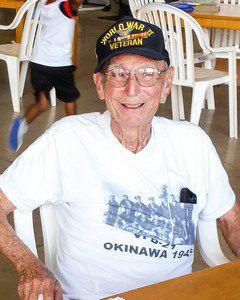
The age of rocketry — past and present — was marked at Miami Executive Airport during a colorful series of special events at Wings Over Miami Air Museum on July 16, the 47th anniversary year of the Apollo moon landing.
Dozens of rocket models added interest to a “Shoot for the Stars” celebration, provided by members of the Homestead Rocket Club to enhance the tribute to early space pioneers and defense projects. Tamiami Composite Squadron Civil Air Patrol cadets, along with Suze Rice, president of Wings, welcomed visitors.
“It is programs like these that continue to make Wings exhibits a visual foundation for appreciation of both the future of aviation and the marvels to come during explorations of the Universe,” Rice said.
Harry Pillot, a National Parks Service volunteer, recaptured the tense moments of the October 1962 “Missile Crisis” when a battery of young U.S. Army recruits manned the Nike Hercules Missile Base that still stands today in Everglades National Park as a National Historic Place, open for public tours from December through March.
Living in tents, the young soldiers (some in their teens) braved intense heat and mosquitoes while enduring 24-hour shifts awaiting commands from USAF officials that would require a six- to 15- second decision to fire the missiles toward Russian missile bases in Cuba.
Other missile sites, operated by the U.S. Air Force and Department of Defense, were located off Krome Avenue, SW 41th Street, SW 183rd Street, Card Sound Road and US 1. A total of 36 missiles were then located in South Florida and the Florida Keys at Key Largo and Islamorada, all with a 200-mile target range.
The “Alpha” Battery today includes 22 buildings with three missile barns, an assembly building, guard dog kennel and barracks.
On hand to greet the crowd was Todd Silverman, 91, WWII Aviation Radar Airman, who offered booklets of the U.S. Constitution with the names of colonial signers and historic dates.
In 1945, Silverman flew 21 missions of 15-hour duration from Okinawa to the coast of China and Korea, surviving three typhoons in PBY-5 Catalina Super Cat and PBM-5 aircrafts during the A-bomb missions.
NASA pioneer presents space exploration update
Retired NASA engineer Russell Romanella captured the Wings audience with a colorful update, noting that former shuttles to the International Space Station are now being replaced with commercial Orbital and SpaceX company vehicles to service the ISS.
Following a 15-year period to build and equip the station, shuttles were retired due to the intensity of wear over years of round trips to Earth.
At first a project computer programmer, Romanella became director of NASA Payloads for the manned Shuttle System to and from Kennedy Space Center to the astronauts on the ISS.
Detailing a concise history of space exploration, Romanella displayed an awesome array of photos taken from the ISS. Hi-tech equipment has now recorded a total number of asteroids at 700,000, he said.
He stated that human cruises to Mars must provide safe protection from solar radiation as well as provision for nutrition during and after such lengthy trips.
A human standing on the Martian surface would need to withstand a temperature of zero degrees at the head height and 80 degrees at foot.
While Mars has no protective magnetic field, research has discovered a shallow, salty sea with hot springs below the Martian surface as a potential similarity with Earth’s features.
Romanella grew up in Miami graduating from Southwest Miami Senior High. He joined a college co-op program with NASA prior to graduation from Florida State University in 1982.






